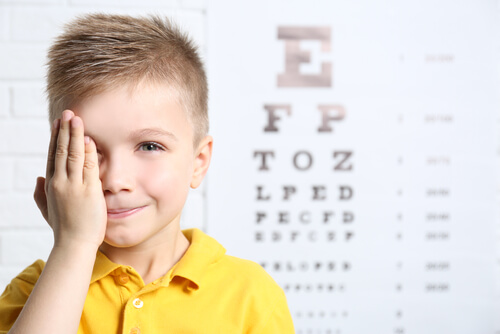Farsightedness in Children: What Is It and How to Correct It


Written and verified by the doctor Nelton Ramos
Learn about farsightedness in children and everything you need to know in this article.
If you notice that your child doesn’t see close up very well, they tell you that their eyes get tired or they get a headache after reading for a little while, they might have a vision problem.
Farsightedness in children is a vision impairment that consists of blurriness when seeing what’s close or near to them.
The overexertion that their eyes do to compensate for this blurry vision could cause visual fatigue and headaches. For children, it can also make their school-related activities more difficult.
This isn’t a progressive defect since the difficulty doesn’t increase over time, but it can become chronic. This means they’ll most likely need glasses permanently.
In this article, we’ll tell you some warning signs that will help you identify farsightedness in children.
Possible Signs of Farsightedness in Children
After approximately 4 years old, the problem of farsightedness could develop. Although the pediatrician usually does a vision test, here we’ll tell you some symptoms that can help you know if your child has a vision problem.
- Squints their eyes to read or see the television. The gesture of squinting their eyes is a sign that they’re trying to accommodate their vision. They will try to squint their eyes to stop seeing things blurry and compensate for their vision.
- Tells you their eyes are tired. When looking at things they make a lot of effort and they could get small headaches.
- They have a hard time concentrating. At school, it’s common for attention problems to occur due to vision issues. Not seeing well makes it harder for the child to follow along in class.
- Strabismus. In some cases, one or both eyes could begin to deviate to compensate for the vision difficulty.

What to Do to Correct Farsightedness in Children?
When you suspect that your child may have a vision problem, the best thing to do is consult your pediatrician. Ask for some eye exams for your child and you can all confirm the diagnosis.
You can correct farsightedness in children with the following techniques:
- Use of glasses. Depending on the age and level of the vision problem, your doctors will help you find the right pair of glasses for your child.
- Eye laser surgery. This is the most used method. It corrects the defect with a little laser by raising a small layer of the cornea that will be put back after.
- Surface techniques. They use a laser to correct the curvature of the cornea, which impedes correct vision. After, they place a protective lens and their vision will progressively recover.
- Placement of intraocular lens. This refers to the phakic intraocular lens, which is where they implant a lens between the iris and crystalline lens. It’s unique for each eye.
Choosing one method over another depends on the ophthalmologist, since they will determine the best solution while keeping in mind the specific characteristics of your child’s farsightedness.
Vision is the touch of the spirit.
–Fernando Pessoa–
Operating on Children with Farsightedness
First, the end goal of refractive surgery or operation to correct vision defects is to prevent your child from needing to wear glasses for the rest of their life.
It’s true that farsightedness could possibly fix itself over time, but if it doesn’t, you can decide to have a surgical intervention.
It’s a simple operation that takes about 10-20 minutes and doesn’t have a complicated postoperative period. It doesn’t require general anesthesia and your child won’t have very much risk.
To make this decision, the ophthalmologist should supervise the process. To operate, the farsightedness should be stable and not get worse, because then it wouldn’t make sense to intervene yet.

A Curiosity
We are all born farsighted. Our vision system takes a little while to develop definitively, so we’re born with pretty defective sight.
Normally, this defect will fix itself over time, also due to complete and continued exposure to different visual stimuli. If it doesn’t correct itself properly, vision problems like farsightedness could develop in children.
Learn about farsightedness in children and everything you need to know in this article.
If you notice that your child doesn’t see close up very well, they tell you that their eyes get tired or they get a headache after reading for a little while, they might have a vision problem.
Farsightedness in children is a vision impairment that consists of blurriness when seeing what’s close or near to them.
The overexertion that their eyes do to compensate for this blurry vision could cause visual fatigue and headaches. For children, it can also make their school-related activities more difficult.
This isn’t a progressive defect since the difficulty doesn’t increase over time, but it can become chronic. This means they’ll most likely need glasses permanently.
In this article, we’ll tell you some warning signs that will help you identify farsightedness in children.
Possible Signs of Farsightedness in Children
After approximately 4 years old, the problem of farsightedness could develop. Although the pediatrician usually does a vision test, here we’ll tell you some symptoms that can help you know if your child has a vision problem.
- Squints their eyes to read or see the television. The gesture of squinting their eyes is a sign that they’re trying to accommodate their vision. They will try to squint their eyes to stop seeing things blurry and compensate for their vision.
- Tells you their eyes are tired. When looking at things they make a lot of effort and they could get small headaches.
- They have a hard time concentrating. At school, it’s common for attention problems to occur due to vision issues. Not seeing well makes it harder for the child to follow along in class.
- Strabismus. In some cases, one or both eyes could begin to deviate to compensate for the vision difficulty.

What to Do to Correct Farsightedness in Children?
When you suspect that your child may have a vision problem, the best thing to do is consult your pediatrician. Ask for some eye exams for your child and you can all confirm the diagnosis.
You can correct farsightedness in children with the following techniques:
- Use of glasses. Depending on the age and level of the vision problem, your doctors will help you find the right pair of glasses for your child.
- Eye laser surgery. This is the most used method. It corrects the defect with a little laser by raising a small layer of the cornea that will be put back after.
- Surface techniques. They use a laser to correct the curvature of the cornea, which impedes correct vision. After, they place a protective lens and their vision will progressively recover.
- Placement of intraocular lens. This refers to the phakic intraocular lens, which is where they implant a lens between the iris and crystalline lens. It’s unique for each eye.
Choosing one method over another depends on the ophthalmologist, since they will determine the best solution while keeping in mind the specific characteristics of your child’s farsightedness.
Vision is the touch of the spirit.
–Fernando Pessoa–
Operating on Children with Farsightedness
First, the end goal of refractive surgery or operation to correct vision defects is to prevent your child from needing to wear glasses for the rest of their life.
It’s true that farsightedness could possibly fix itself over time, but if it doesn’t, you can decide to have a surgical intervention.
It’s a simple operation that takes about 10-20 minutes and doesn’t have a complicated postoperative period. It doesn’t require general anesthesia and your child won’t have very much risk.
To make this decision, the ophthalmologist should supervise the process. To operate, the farsightedness should be stable and not get worse, because then it wouldn’t make sense to intervene yet.

A Curiosity
We are all born farsighted. Our vision system takes a little while to develop definitively, so we’re born with pretty defective sight.
Normally, this defect will fix itself over time, also due to complete and continued exposure to different visual stimuli. If it doesn’t correct itself properly, vision problems like farsightedness could develop in children.
All cited sources were thoroughly reviewed by our team to ensure their quality, reliability, currency, and validity. The bibliography of this article was considered reliable and of academic or scientific accuracy.
- Díez del Corral Belda JM, Álvarez Alonso C. Oftalmología pediátrica para todos los días. En: AEPap (ed.). Curso de Actualización Pediatría 2016. Madrid: Lúa Ediciones 3.0; 2016. p. 521-32.
- Sánchez Verdiguel I, Bosch V, Ordaz-Favila JC. Problemas de visión más frecuentes en pediatría. Acta Pediatr Mex 2011;32(4):251-254.
This text is provided for informational purposes only and does not replace consultation with a professional. If in doubt, consult your specialist.








